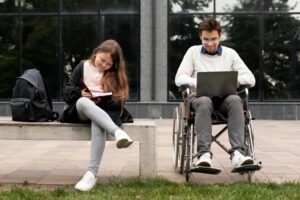From Application to Implementation: Understanding HEI's Process for Accessible Learning Tools
Materials
1. Introduction
In the digital age, technology is revolutionizing the way we learn. For students with disabilities, it can be a lifeline, opening doors to education that were once closed. Universities play a crucial role in ensuring that all students, regardless of their abilities, have the same opportunities to succeed. That’s why establishing a tablet rental scheme is so vital. It’s more than just providing devices; it’s about giving students the tools they need to thrive academically (Ågren, 2020).
This comprehensive guide will walk through the steps of creating a successful tablet rental program, from assessing student needs to procuring the right devices and software. But it doesn’t stop there. It also delves into the broader picture of fostering a truly inclusive university environment. This involves adapting physical spaces, educating faculty and staff, and promoting a culture of understanding and acceptance. It’s a recognition that inclusivity is not just about technology, but about creating a space where everyone feels welcome and supported (Bricout et al., 2021).
2. Setting up a rental scheme for tablets
2.1 Renting scheme:
To allow students with disabilities to enjoy the benefits of these devices it is necessary to have some sort of renting system. For it to be a successful system it has to consider who the target of this service is and how to reach it. Special care is required in spreading awareness about this system through media that are accessible to all students with disabilities (NDIS, 2023).
Assess Needs and Demand:
- Conduct surveys or interviews to assess the demand for tablet rentals among students with disabilities.
- include in the application form of the university a question that addresses this need (Simpson et al., 2017).
- Identify specific disabilities and accessibility requirements to tailor the tablet options and software features accordingly. It would be useful to know whether the university’s students have learning disabilities or other types of disabilities
Establish Policies and Guidelines:
- Develop clear policies and guidelines outlining the eligibility criteria, rental terms, fees (if any), responsibilities, and usage regulations.
- Ensure compliance with accessibility standards and legal requirements which might differ from country to country
Procure Tablets and Assistive Technologies:
- Procure a variety of tablets equipped with built-in accessibility features and compatibility with assistive technologies. Some examples are given later in the text
- Consider partnerships with local vendors or assistive technology providers to obtain discounted rates or donations (Simpson et al., 2017).
Configure Tablets with Assistive Software:
- Install and configure assistive software and accessibility features on the tablets to meet the diverse needs of users with disabilities.
- Offer training sessions or tutorials to familiarize users with the functionalities and customization options of the tablets.
Establish Rental Procedures:
- Create an accessible online platform or system for students with disabilities to apply for tablet rentals and manage rental agreements. Some features to keep in mind are for example, color contrast, size of the font, compatibility with softwares used as assistive technology
- Implement a transparent and efficient process for reviewing applications, verifying eligibility, and allocating tablets based on availability.
Provide Technical Support and Maintenance:
- Offer technical support services to troubleshoot issues, provide guidance on accessibility settings, and assist users with software customization.
- Establish a system for regular maintenance, repairs, and upgrades to ensure the reliability and functionality of the rented tablets. This could be done together with the IT department of the University
Promote Awareness and Accessibility:
- Launch marketing campaigns and informational sessions to raise awareness about the tablet rental program and its benefits for students with disabilities (Ågren, 2020).
- Collaborate with disability support services, student organizations, and campus departments to promote inclusivity and accessibility initiatives.
- It is important to consider how to promote this program in a way that it will reach people with disabilities, so this step has to be specially tailored for this audience. For example, if these services were to be broadcasted on some university’s screens, make sure to include in the video a sign language interpreter.
Evaluate and Improve the Program:
- Collect feedback from participants through surveys, focus groups, or feedback forms to evaluate the effectiveness of the rental program. For instance, it might be interesting to evaluate how they first came across the service. It would also be very important to assess if the AT was effective.
- Use feedback to identify areas for improvement, address concerns, and enhance the accessibility, usability, and overall experience of the program. It would be helpful to organize focus groups about the students’ experience.
Ensure Sustainability and Funding:
- Secure sustainable funding sources to support the ongoing operation and expansion of the tablet rental program.
- Explore partnerships with external organizations, alumni donors, or grant funding opportunities to supplement university resources. (Digital Europe Program)
3. Additional steps: how can your university create a more inclusive environment:
Creating an inclusive environment for people with disabilities within the university setting is not only a moral obligation and a Universities hold a unique position to lead the charge in promoting inclusion and accessibility for all students. To achieve this goal effectively, various strategies can be implemented to address the diverse needs of students with disabilities (NDIS, 2023).
3.1. Adapting lecture halls is a fundamental step towards fostering inclusivity. Many assistive devices used by students with disabilities, such as hearing aids or communication devices, rely on electricity. Fitting lecture halls with accessible plugs ensures that students who rely on these devices do not face the anxiety of having them run out of battery during lectures. This seemingly simple modification can significantly alleviate concerns and remove barriers to participation for students with disabilities.
3.2. Promoting technological literacy and support among university staff is paramount for creating an inclusive learning environment. Faculty members and lecturers play a pivotal role in ensuring that lectures and course materials are accessible to all students, including those with disabilities. Providing staff with comprehensive training on effective communication strategies and accessibility guidelines is essential. Specialized training programs focusing on understanding and utilizing assistive devices can empower staff to effectively support students with disabilities.
3.3. Raising awareness among professors about the presence of students with disabilities in their classes can foster a more inclusive and accommodating learning environment. Furthermore, purchasing hardware is a crucial aspect of promoting inclusivity in higher education. While some students may own their assistive devices, others may find them prohibitively expensive. Universities can bridge this gap by investing in a variety of assistive technologies that cater to different disabilities. For instance, acquiring tablets equipped with accessibility software can greatly enhance the learning experience for students with visual or cognitive impairments. These devices can be made available for loan to students who require them, ensuring equal access to educational resources and opportunities.
In addition to tangible adaptations, fostering a culture of inclusivity and accessibility within the university community is essential. Creating spaces where students feel comfortable disclosing their disabilities and requesting accommodations is crucial. Universities should prioritize creating policies and procedures that promote transparency, confidentiality, and respect for the diverse needs of students with disabilities.
In summary, promoting inclusivity and accessibility in universities requires a comprehensive and proactive approach. By implementing strategies such as adapting lecture halls, providing technological literacy training for staff, and investing in assistive technologies, universities can create an environment where all students, regardless of their abilities, can thrive academically and personally. Ultimately, fostering inclusivity not only benefits students with disabilities but enriches the entire university community by promoting diversity, equity, and excellence in education.
4. Conclusion
Creating a truly inclusive university environment for students with disabilities is a multifaceted endeavor that goes beyond simply providing tablets. It requires a holistic approach that addresses both the physical and cultural aspects of university life. Adapting spaces to ensure accessibility, equipping staff with the knowledge and tools to support students with diverse needs, and fostering a culture of understanding and acceptance are all crucial components.
Providing tablets is a significant step, but it’s only one part of a larger effort to create a campus where everyone feels valued and empowered to succeed. By addressing both the tangible and intangible barriers faced by students with disabilities, universities can create a more enriching educational experience for everyone. It’s a journey that requires ongoing commitment and collaboration, but the rewards are immeasurable. A truly inclusive university is one where diversity is celebrated, and where everyone has the opportunity to reach their full potential.
Reference
Ågren, K. A. (2020). Internet use and digital participation in everyday life: Adolescents and young adults with intellectual disabilities (Vol. 1734). Linköping University Electronic Press.
Bricout, J., Baker, P. M., Moon, N. W., & Sharma, B. (2021). Exploring the smart future of participation: Community, inclusivity, and people with disabilities. International Journal of E-Planning Research (IJEPR), 10(2), 94-108.
https://www.igi-global.com/article/exploring-the-smart-future-of-participation/262511
NDIS. (October, 2023). What if you need to rent assistive technology items?
What if you need to rent assistive technology items? | NDIS
Simpson, Elisabeth & Loy, Beth & Hartnett, Helen. (2017). Exploring the Costs of Providing Assistive Technology as a Reasonable Accommodation. Journal of Applied Rehabilitation Counseling. 48. 26-31. 10.1891/0047-2220.48.2.26.
3. Infrastructure and Equipment/ Tools and Technology
Accessible Infrastructure for Inclusive Education
digital infrastructure that supports inclusive and accessible education
10 min
At the end of this Unit, you will be able to:
– Recognize the digital devices employed to make HE inclusive
– Explore practical strategies for creating inclusive learning environments.
– Reflect on your role in fostering collaboration and engagement.
tools, digital infrastructure, equipment, physical accessibility, Inclusive Digital Education, Student Engagement, Collaborative Learning, Flexible Classroom Designs,








Funded by the European Union. Views and opinions expressed are however those of the author(s) only and do not necessarily reflect those of the European Union or the European Education and Culture Executive Agency (EACEA). Neither the European Union nor EACEA can be held responsible for them (2022- 1 -SI01 -KA220-HED-000088368).






